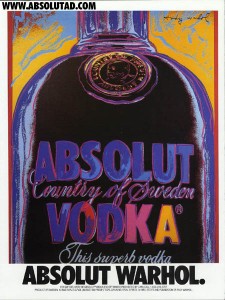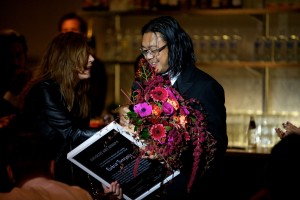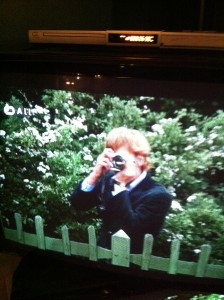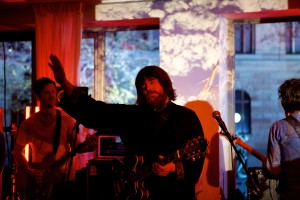In the finale of our Absolut Art Award coverage, Art Life editor Andrew Frost is given exclusive entry to a super-secret room, more free drinks than he knows what to do with, and is serenaded by the soundtrak of our lives…
We’re on a bus on our way to a secret location on the outskirts of Stockholm. Locked away in a grey room inside an anonymous industrial estate is the Absolut Art Collection, the 895 or so art works that were made as part of Absolut’s two and a half decade-long art-themed advertising campaign.
With paintings and sculptures by artists including Andy Warhol, Damien Hirst, Francesco Clemente, Louise Bourgeois, Ed Ruscha, Douglas Gordon, Keith Harring and Lisa Yuskavage, to name just a few, the collection is now considered so valuable that we are forbidden to even know the address of the storage facility or take photographs while we’re on the site.
We stand outside the building wondering what it’s all going to look like, smoking cigarettes, peering through the high wire fences and gates to the drab building. Although few of the 50 or so assorted journalists, magazine editors, bloggers and pr people who’ve been flown in from 17 countries at the company’s expense would have the faintest idea where we are, the secrecy and security of the operation is taken very seriously indeed.
In 1985 Warhol approached Absolut with the idea of painting the bottle as part of an ad. It was a canny contra-deal cooked up to get more advertising into Warhol’s Interview magazine and, recognising a great marketing idea, the company agreed. A sequence of ads followed that defined the brand and its close association with the art world, and in turn created a daisy chain of artists recommending one another for the gig. From Warhol to Harring to Kenny Scharf and so on over the years until now Australian landscape photographer Murray Fredericks has collaborated with the company to produce a work for a new “limited edition” vodka.
The question of the relationship between the corporate world, advertising and art has always been vexed. Much contemporary art prides itself on its critical relationship to capitalism, questioning the iniquities of life under its rule and foregrounding the political conflicts that define us. But on the other hand, who doesn’t like the glamour of art? Indeed, who doesn’t like a nice cocktail once in awhile?
The main purpose of my Scandinavian escapade was to witness the ceremony surrounding the Second Annual Absolut Art Award. In 2008 Absolut, which had been owned by the Swedish government, was sold to Pernod Ricard, one of the world’s largest wine and spirits companies. Along with Absolut, Pernod and dozens of other international brands, Pernod Ricard distributes Australian wines including Wyndham Estate and Bundaberg Ginger Beer.
The Swedish government decided to hold on to the art collection, and so, strategising new ways to keep the art/vodka relationship alive, the idea was hatched for a 15,000 euro prize that would be awarded to an artist with a notable career and art making that would somehow compliment the product’s brand values. Enter Argentinean-born, Thai artist Rirkrit Tiravanija, the winner of the prize for 2010 and an artist who doesn’t make actual art objects but rather he is an artist who does performances and creates ‘situations’ that people share, such as cooking up tasty Thai dishes for gallery visitors or recreating his New York apartment in a gallery space. One of the only permanent art works that Tiravanija has created is The Land Foundation – an ongoing project what he jokingly refers to as a “retirement home for artists” – a farming community in Chiang Mai in Thailand, co-owned by Tiravanija, that’s comes complete with prefab eco-friendly housing and “collaborative harvests” where visitors are invited to help harvest the annual rice crop.
The award dinner at the Absolut Atelier was a black tie affair with Tiravanija in a dickie bow and assorted beautifully dressed Absolut people including Philippe Guettat, CEO of Absolut, Anna Malmhake VP of Global Marketing, assorted art world figures including prize judges Christine Macel, chief curator at the Pompidou, and Thomas Nordanstad, jury spokesperson and dapper Swedish art-world gadfly, and just-there-for-the-night Daniel Birnbaum who had recently taken up the role of director at the nearby Moderna Museet. With such illustrious company, the seemingly endless plates of food brought out by waiters, bottomless glasses of red and white wine, an open bar serving cocktails and an in-house DJ situated somewhere up near the roof pumping out an avalanche of little beats, one had to admit that the award ceremony was both convivial and superbly catered. Up at the main table, Tiravanija and VIPs enjoyed a floor show by an exquisitely expressive pianist and vocalist duo. The jury’s citation for Tiravanija read in part that “Rirkrit Tiravanija is awarded the Absolut Art Award 2010 for his ability to rule out conventional categorization. Tiravanija’s expressive world is one of hospitality and generosity. Through social events, cooking, sharing and architectural environments, often reflecting on art, Rirkrit humbly invites the audience to interact.”
As I sat at a table surrounded by journalists from Mexico, Spain, Russia, Turkey, the United States and England, it occurred to me that old-world concerns about the co-opting of art and art making by corporate interests were essentially passé. For artists of Tiravanija’s calibre any apparent contradiction in creating ‘objectless’ art works – and the challenge that such a practice poses to the economic imperatives of the museum and the market – and accepting awards from multinational companies – simply don’t exist. Awards such as the Absolut Award and the Hugo Boss Award represent a corporate engagement with the realities of international art practice, and in Absolut’s case, a determination to engage with the cutting edge of art that embodies, no matter how abstractedly, with the brands core values. Talking with Anna Malmhake, I was gently informed that for Absolut these are “brand beliefs” not mere values, and that although somewhat abstract as well, there is something of a connection to Tiravanija’s practice, namely, the ideas of community, collaboration and creativity. I suppose if you’re going to have beliefs, they’re good ones to have.
The Absolut people were thrilled to show off the various rooms of the recently revamped Atelier. In the basement there was a sculptural installation of glass tubes and metal taps with a slash of neon in the middle declaring the words “one source” [a tribute to Absolut’s single crop used for their vodka fermentation process], a creative room for their creatives to be, well, creative [polished wood table, floors and flowers in vases] and a super-secret “point of sale” room with highly sensitive marketing material that I am forbidden from revealing. Upstairs at the Atelier was a kitchen and a male/female toilet fitted out with three stacked television screens showing a DVD of Michelangelo Antonioni’s Blow Up.
The key room on the tour of the Atelier was the “target market room” – a bedroom and walk-in wardrobe that was apparently representative of the taste and cultural aspirations of the typical Absolut consumer. With a massive queen-sized bed bedecked with cushions, pillows and fake fur blankets, a huge LCD TV screen, five vintage PS1 controllers and a video and game collection that took in everything from Halo to blaxploitation movies, I couldn’t quite recognise myself in the mix. The walk-in wardrobe, aside from individually pegged designer denim on one wall, was set up with a full drum kit, a Fender Stratocaster and a stack of Marshall amps. Now this was more like it. Who doesn’t like getting up in the morning and blasting out a few vintage Ramones songs before breakfast? More importantly, who wouldn’t want to?
Back at the anonymous storage facility we are finally led into the building and instructed to leave our coats and accompany the Absolut Collection’s charming curator Mia Sundberg into a staff lunchroom where coffee, cheese rolls and pastries await us. Once more we are instructed – no cameras. We’d be taken in groups of six into the special room to see the individual art works. Notable examples of the collection were set out in a hallway. Warhol’s original Absolut painting sits on an easel, one of the two paintings made by Ed Ruscha, next to it, Douglas Gordon’s canvas that had been repeatedly painted with vodka [explanatory text included in the work] segued into pieces by Vik Muniz, Rosmarie Trockel and Kenichiro Mizuno. And then, finally, I was allowed into the storage facility. All I can tell you about it is that it’s full of art – full to the brim, stacked everywhere, up and down the walls, and in every conceivable vertical space in the stacks. Nothing could really be seen in its best light – I spied Chris Ofili’s canvas featuring obligatory elephant turd, glitter and Absolut bottle sticking out from behind another painting. After three minutes we were ushered out and then, after about 30 minutes, back onto the bus and down the long freeway to Stockholm.
The final evening of my stay in Stockholm was a party at the Lydmar Hotel, a swanky boutique establishment right on the edge of the harbour. You knew that the night was going to be special when, on arrival, the foyer was part of an in-house light show – a single 35mm slide projector throwing images of Soviet space vehicles, landers and portraits of cosmonauts over the cloak room. The crowd that packed out the first floor restaurant were there to see the legendary singer Ebbot Lundberg of Swedish band The Soundtrack of Our Lives lead a 13 piece pick up band through classic TSOOL numbers culminating in a 30 minute long jam session on The Door’s The End. Absolut hosted the party and drinks were both free and plentiful. Lundberg, who looks like a kind of rock n roll monk, and his band ripped up the place as disconcerted diners ate crepes and party-goers crowded in. Behind the band I could see the lights of Stockholm beyond, beautiful and twinkly in the frigid air. I wondered what it all meant, and then thought, who cares, it looks beautiful.





Pingback: Tweets that mention Absolut Finale | The Art Life -- Topsy.com
cheers